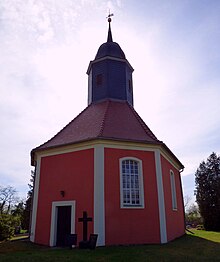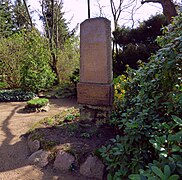Nieska village church
The Evangelical Lutheran village church Nieska is a listed church building in Nieska , a district of the small town of Gröditz in the north of the Saxon district of Meißen . The building, built in the middle of the 18th century in the baroque style based on the model of the Dresden Frauenkirche , can be found in the center of the village with an adjoining cemetery .
history
A church in Nieska is documented as early as the 15th century, which had a branch church in Lichtensee . However, Lichtensee was assigned to the church in Streumen immediately after the Reformation . Over the centuries Nieska's church affiliation changed and she was assigned to the church in Nauwalde . For some time it was also a parish church itself and had its own branch churches, such as Spansberg and Tiefenau .
The church that exists today in Nieska was built in the Baroque style between 1750 and 1751 under the direction and probably also according to the plans of Pastor Christian Gottfried Tzschiedrich. A previous building located here was demolished beforehand. The Dresden Frauenkirche served as a model for the church . In the years 1840 and 1841 the structure was renewed again. An interior renovation of the church took place in 1951. There were further restoration measures from 1979, which have not been fully completed to the present day and are partly supported by the Dutch partner community. The external renovation was completed in the years 2008 to 2010.
At present, Nieska and the parishes of Frauenhain , Gröditz , Nauwalde , Spansberg , Merzdorf and Koselitz make up the parish of Gröditz .
The Nieska Church and its furnishings are now a listed building.
Building description
The Nieska Church is a plastered quarry stone building with a tent roof. The elongated octagonal hall building also has an octagonal tower in the form of a roof turret , which has a slate-covered tail hood . A weather vane can be found at the top, which was decorated with the initials of the founder, Count Wackerbarth (owner of the Zabeltitz manor ) and the year 1750.
Furnishing
The interior of the church has a flat roof. It is provided with single-storey galleries on three sides . There is also a baroque pulpit altar made of wood with a rather crude pulpit parapet, which bears a strong resemblance to the altar in the Spansberg church . Like the Nieska church, the Spansberg pulpit altar was also built in the middle of the 18th century. Boxes, so-called prayer rooms, can be found on both sides of the altar.
organ
The organ in the church today dates from 1862. The instrument was created by the Großenhain organ builder Gottlob Heinrich Nagel (1805–1883). The organ has seven registers on a manual and pedal .
The disposition is as follows:
|
|
||||||||||||||||||||
- Coupling : I / P
Dunning and remembrance
In the immediate vicinity of the church, in a park-like green area on a stamped concrete base, there is a memorial to the fallen in the form of a granite stele. The memorial with an inscription commemorates the villagers of the Nieska community who died in the First World War .
A granite plaque attached to it later bears the names of the villagers who died and went missing in World War II . Like the church, the Fallen Memorial is under monument protection.
Immediately in front of the church is the grave of the former pastor of Nauwalde, Nieska, Tiefenau and Spansberg Albert Seeliger (1886–1952), who worked here from 1926 to 1952 and the cantor Elisabeth Seeliger (1903–1989).
Literature (selection)
- Cornelius Gurlitt : Official Authority Grossenhain (Land) . Dresden 1914, p. 196-198 ( Scan - Internet Archive ).
Web links
- Homepage of the Evangelical Lutheran Congregation Gröditz with Spansberg, Nauwalde and Nieska
- The Nieska Church on the homepage of the church district Meißen-Großenhain
Notes and individual references
- ↑ a b c d List of monuments of the State of Saxony , accessed on October 12, 2017
- ↑ a b c d e The Nieska Church on the homepage of the church district Meißen-Großenhain , accessed on October 9, 2017.
- ↑ a b Nieska's entry in the Digital Historical Directory of Saxony , accessed on September 14, 2017.
- ^ Entry Lichtensee in the Digital Historical Directory of Saxony , accessed on September 14, 2017.
- ↑ Cornelius Gurlitt: Amtshauptmannschaft Grossenhain (country) . Dresden 1914, p. 196-198 .
- ↑ a b c d Georg Dehio: Handbook of German art monuments - Saxony I . 2nd Edition. 1996, ISBN 978-3-422-03043-5 , pp. 644 .
- ↑ a b Homepage of the Evangelical Lutheran Congregation Gröditz with Spansberg, Nauwalde and Nieska , accessed on October 10, 2017.
- ↑ Internet presence of the church district of Meißen-Großenhain , accessed on November 9, 2016.
- ↑ Cornelius Gurlitt: Amtshauptmannschaft Grossenhain (country) . Dresden 1914, p. 382-387 .
- ↑ Uwe Pape (Ed.): Lexicon of North German Organ Builders . tape 2 : Saxony and bypassing . Pape Verlag, Berlin 2012, ISBN 978-3-921140-92-5 , pp. 267 .
- ↑ a b Data sheet of the Nieskaer Nagelorgel on the homepage of the church district Meißen-Großenhain, accessed on September 15, 2017.
- ↑ a b Online project memorials for the fallen , accessed on October 12, 2017
Coordinates: 51 ° 23 '28.1 " N , 13 ° 23' 54" E






